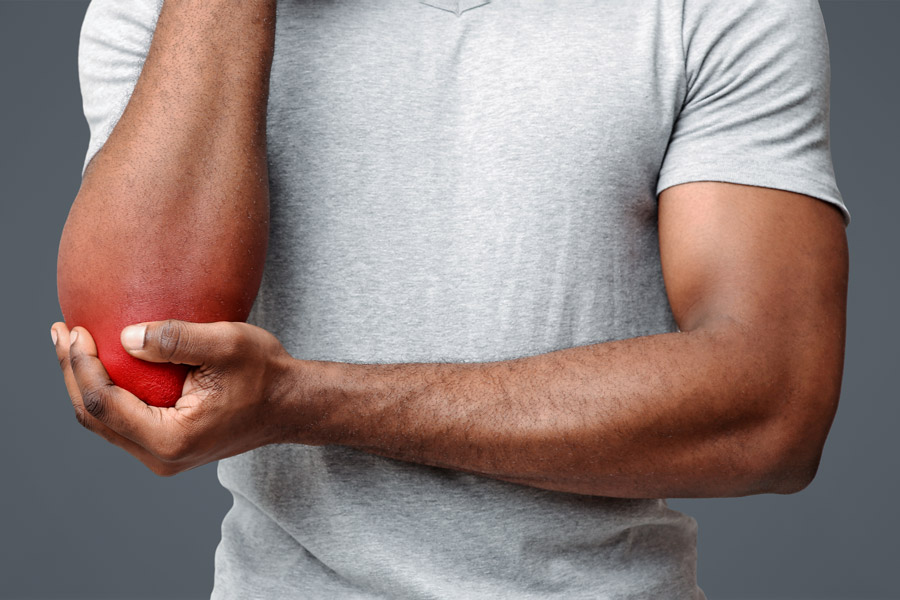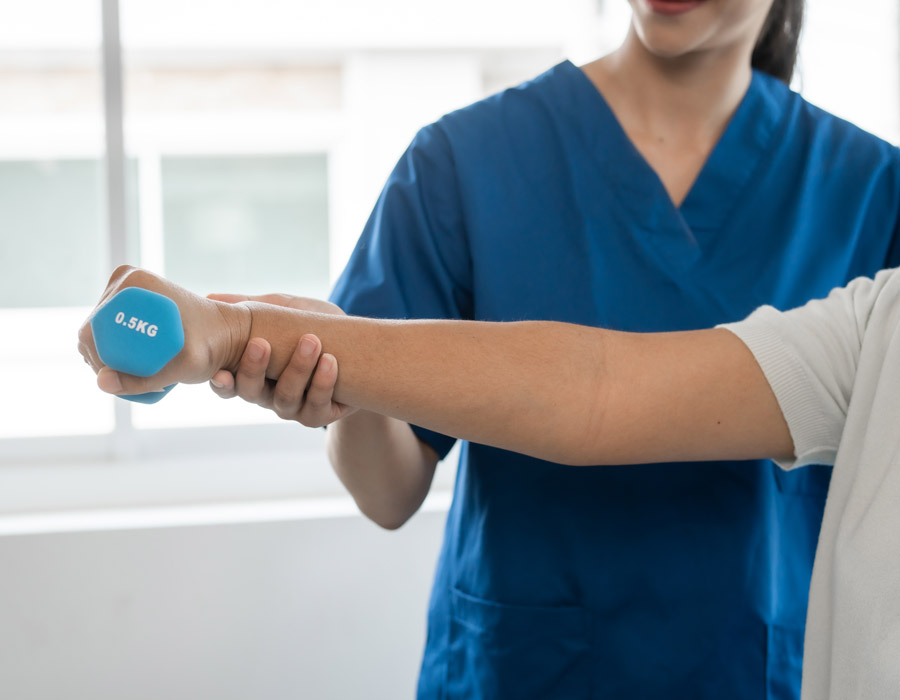Ellenbogen
Ellenbogenschmerzen: Ursachen, Diagnose und moderne Therapie
Ellenbogenschmerzen können viele Ursachen haben – von Überlastung im Alltag und Sport über rheumatische Erkrankungen bis hin zu akuten Verletzungen. Eine präzise Diagnostik mittels klinischer Untersuchung und bildgebender Verfahren (Röntgen, MRT) ist entscheidend, um die richtige Therapie zu bestimmen. Neben konservativen Maßnahmen stehen arthroskopische und offene Operationsverfahren zur Verfügung. Im Folgenden stellen wir die häufigsten Erkrankungen und deren Behandlungsmöglichkeiten vor.
Akute Verletzungen des Ellenbogens
Schnelle Wiederherstellung & frühzeitige Mobilisation
Minimal-invasive OP-Techniken für geringere Belastung
Gezielte Nachsorge für optimale Heilung & Stabilität
Ellenbogenluxationen: Ursachen und Behandlung
Die Ellenbogenluxation ist mit 20 % aller Luxationen die zweithäufigste des Menschen. Dabei kommt es stets zu Kapsel-Band-Zerreißungen (100 %) sowie oft zu Knorpelverletzungen (30–50 %) und sogar zu Frakturen der Gelenkpartner (20–30 %). Seltener treten Gefäßverletzungen (3–4 %) oder dauerhafte Nervenschäden (3 %) auf.
Behandlung
Nach der Reposition werden die Schäden evaluiert, um die Therapie festzulegen:
- Konservativ: Einfache Luxationen mit Einzelbandzerreißung können ohne OP behandelt werden.
- Operativ: Bei der Zerstörung mehrerer primär stabilisierender Bänder ist eine Rekonstruktion nötig. Dabei werden die Bandstümpfe an ihrer ursprünglichen Stelle refixiert, um eine stabile Gelenkfunktion wiederherzustellen.
Nachbehandlung
- Physiotherapie beginnt direkt am Tag nach der OP.
- Nach Abschwellen des Arms wird eine Bewegungsschiene mit limitierter Bewegung für 6 Wochen getragen.

Distale Bizepssehnenruptur: Abriss der Sehne
Der Abriss der Bicepssehne nahe dem Ellenbogengelenk an der Speiche des Unterarms (Radius) geschieht entweder durch einen Unfall oder durch chronische Überlastung. Sie führt zu deutlichem Kraftverlust und ist klinisch gut nachweisbar.
Behandlung
- Konservativ: Ermöglicht nur eine schmerzfreie Bewegung, die volle Kraft wird nicht wiederhergestellt.
- Operativ: Zur Wiederherstellung der Unterarmrotation und Ellenbogenbeugung wird die Sehne minimal-invasiv mit Fadenankern am Radius refixiert.
Nachbehandlung
- Physiotherapie beginnt direkt am ersten Tag nach der OP.
- Nach Abschwellen des Arms wird eine Bewegungsschiene für 6 Wochen angelegt.
Knorpelverletzungen des Ellenbogens
Eine Knorpelverletzung am Ellenbogengelenk kann durch direktes Anpralltrauma oder Scherkräfte im Rahmen einer Luxation entstehen. Häufig finden sich Kombinationsverletzungen von Knorpel und Knochen.
Behandlung
- Konservativ: Bei kleinen Defekten möglich.
- Operativ: Größere Fragmente werden refixiert oder durch Mikrofrakturierung bzw. Knorpel-Knochentransplantation (OATS) behandelt.
Nachbehandlung
- Physiotherapie beginnt direkt nach der OP.
- Bewegungsschiene für 6 Wochen zur Schonung.

Plica radialis Syndrom: Weichteilverletzung im Ellenbogen
Die Plica radialis ist eine Weichteilzunge zwischen Gelenkkapsel, distalem Oberarmknochen und Radiusköpfchen. Bei Einklemmung der Plica zwischen den Gelenkknochen kann es zur Verletzung mit weiteren Schmerzen und Schwellung im Verlauf kommen. Der Schmerz tritt am äußeren Ellenbogen auf und kann tageszeitlich sowie in Abhängigkeit von der Aktivität variieren.
Behandlung
- Konservativ: Ruhigstellung und Medikamente.
- Operativ: Falls Beschwerden bestehen bleiben, kann die Plica arthroskopisch entfernt werden.
Nachbehandlung
- Meist kurze Rehabilitationsdauer.
- Patienten sind nach ca. 3 Wochen beschwerdefrei und wieder arbeitsfähig.
Chronische Erkrankungen und Überlastungssyndrome
Effektive Schmerzlinderung & Funktionsverbesserung
Langfristiger Gelenkschutz durch individuelle Therapie
Erhalt der Beweglichkeit & Vermeidung von Folgeschäden

Epicondylitis radialis/ulnaris (Tennis- und Golferellenbogen)
Bei den Begriffen Golfer- oder Tennisellenbogen werden Schmerzen am inneren oder äusseren Gelenkknorren des Ellenbogens zusammengefasst. Die Ursachen liegen in einer Überlastung der Beugemuskulatur (Golferellenbogen) oder Streckmuskulatur (Tennisellenbogen) des Unterarms. Die Überlastung kann durch einseitige Aktivität oder durch eine Bandinstabilität des Ellenbogengelenkes begründet sein. Bei chronischer Überlastung wandert der Schmerz von der Muskulatur ausgehend zu den Ansatzpunkten am Ellenbogen und kann hier zu strukturellen Veränderungen führen. Die Anamnese und klinische Untersuchung wird durch die Sonografie und Kernspintomografie komplettiert.
Behandlung
- Konservativ: Medikamente, Physiotherapie, Ruhigstellung.
- Operativ: Falls konservative Maßnahmen nicht helfen, kann eine arthroskopische Untersuchung erfolgen.
- Bei chronischer Epicondylitis wird eine Operation nach Nirschl zur Rekonstruktion und Stabilisierung durchgeführt.
Nachbehandlung
- Physiotherapie beginnt direkt nach der OP.
- Bewegungsschiene für 6 Wochen.
Ellenbogeninstabilität (radial/ulnar)
Kapselbandinstabilität des Ellenbogengelenkes entstehen durch Kapsel-Band-Schäden und können konservativ behandelt werden.
Behandlung
- Konservativ: Physiotherapie zur Stabilisierung.
- Operativ: Falls die Instabilität bleibt, wird eine diagnostische Arthroskopie durchgeführt. Falls nötig, erfolgt eine Bandplastik.
Nachbehandlung
- Physiotherapie ab dem ersten Tag.
- Bewegungsschiene für 6 Wochen.

Freie Gelenkkörper (GK) im Ellenbogen
Freie Gelenkkörper entstehen durch Unfälle oder degenerative Erkrankungen wie Osteochondrosis dissecans. Sie können zu Gelenkblockaden und Schmerzen führen. Die freien GK können zu Gelenkreiben, Gelenkblockaden und Schmerzen führen.
Diagnose
Neben der klinischen Untersuchung werden Röntgen, CT oder MRT eingesetzt.
Behandlungen
Operativ: Fast immer arthroskopische Entfernung der Gelenkkörper.
Nachbehandlung
Physiotherapie beginnt direkt nach der OP.
Gelenksteife und Bewegungseinschränkung (Arthrofibrose)
Die Gelenkeinsteifung des Ellenbogens ist meist posttraumatisch oder arthrotisch bedingt. Die Behinderung im Alltag durch eine Bewegungseinschränkung steht in Abhängigkeit zu den Bedürfnissen des Patienten. Bereits 20° Beugehemmung können die täglichen Verrichtungen stark stören.
Behandlungen
- Konservativ: Physiotherapie und spezielle Orthesen zur Mobilisation.
- Operativ: Falls keine ausreichende Beweglichkeit erreicht wird, können arthroskopische oder offene Verfahren zur Entfernung von Verwachsungen oder knöchernen Überbauungen durchgeführt werden.
Nachbehandlung
Intensive Physiotherapie für mindestens 6 Wochen zur Sicherung des OP-Ergebnisses.

Arthrose des Ellenbogengelenks
Die Ellenbogenarthrose führt zu Bewegungsschmerzen, Ruheschmerzen und zunehmender Bewegungseinschränkung.
Behandlungen
- Konservativ: Die Arthrose des Ellenbogens kann bis zu einem gewissen Grad konservativ therapiert werden. Es gibt je nach Lokalisation eine Reihe von gelenkerhaltenden Eingriffen um die Arthrose zu beseitigen oder deren Fortschreiten einzudämmen.
- Operativ: Die Endoprothetik (Implantation künstlicher Gelenke) steht am Ende einer Reihe von konservativen und operativ gelenkerhaltenden Maßnahmen. Es kann entweder nur ein Teil des Gelenkes mit einer künstlichen Oberfläche überzogen oder das ganze Gelenk ersetzt werden. Ziel ist es in allen Fällen eine schmerzfreie und gute Ellenbogenfunktion wiederherzustellen.
Nachbehandlung
- Physiotherapie ab dem ersten Tag nach der OP.
- Nachdem der Arm abgeschwollen ist, tragen Sie eine Bewegungsschiene für 6 Wochen zur Schonung.
Jetzt Termin vereinbaren!
Sie leiden unter Ellenbogenschmerzen oder einer Verletzung? Unsere Spezialisten der Sportorthopädie München bieten Ihnen modernste Diagnostik und maßgeschneiderte Therapien.
Lassen Sie sich beraten!
Vereinbaren Sie jetzt einen Termin zur persönlichen Untersuchung und Behandlung:
+49-(0)89 4140-7840
sportortho@mri.tum.de
Haus 524
Ismaninger Str. 22
81675 München

